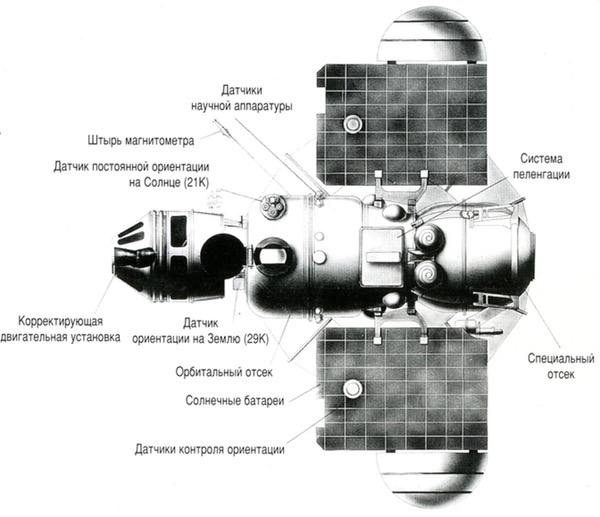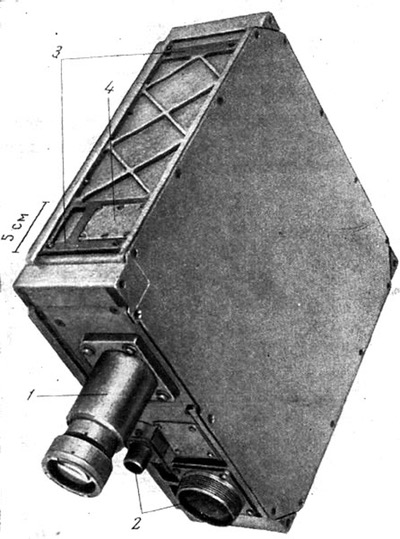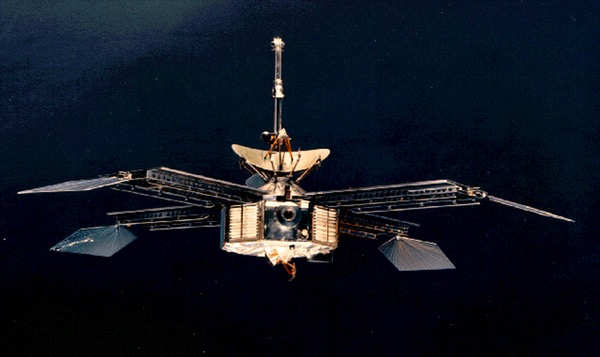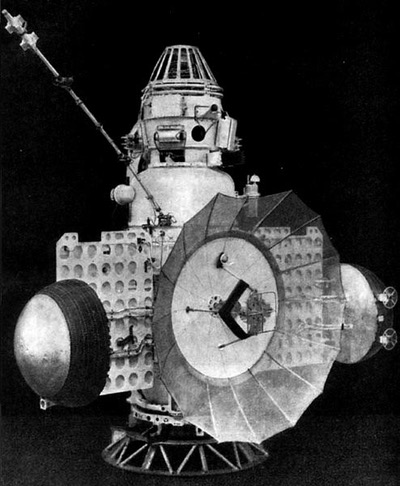The mission of Zond 2by Andrew J. LePage
|
| Even before the last transmission from Mars 1 had been received, the decision had been made to send another half dozen spacecraft towards Venus and Mars during 1964 launch opportunities using an improved spacecraft designated 3MV. |
Unfortunately, all three of the 2MV-series spacecraft launched towards Venus in August and September of 1962 never made it beyond Earth orbit due to problems with the Molniya 8K78 launch vehicle. Likewise, two of the 2MV spacecraft bound for Mars also succumbed to launch vehicle failures two months later. Only the 894-kilogram (1,970-pound) Mars 1, launched on November 1, 1962, managed to survive launch and was sent on its way to Mars. Despite the successful launch, a malfunction in the spacecraft’s attitude control system doomed the mission of Mars 1 to failure months before it ever reached its target.
Even before the last transmission from Mars 1 had been received on March 21, 1963, the decision had been made to send another half dozen spacecraft towards Venus and Mars during 1964 launch opportunities using an improved spacecraft designated 3MV. Like its predecessors, the 3MV series of planetary explorers were designed at OKB-1 led by famed Chief Designer Sergei Korolev. As with the earlier 2MV, the 3.6-meter-tall (12-foot-tall) 3MV consisted of two sections. The first was an orbital compartment that contained control systems, power supplies, and communications gear, as well as some instrument electronics. Mounted on the exterior of this compartment was a pair of solar panels with hemispherical radiators for thermal control mounted on their ends, an umbrella-like high-gain antenna, as well as low-gain antennas and a variety of sensors. The 3MV included a number of design improvements based on the experiences with the earlier 2MV design, such as significantly more redundancy of key systems and the inclusion of a set of experimental plasma engines to serve as a backup to the conventional nitrogen gas jets used for attitude control, which had failed during the flight of Mars 1.
The second section of the 3MV was the planetary compartment that was geared towards specific investigations of the target planet. As before, the planetary compartment came in two varieties: one contained a film-based camera system and a set of ultraviolet and infrared instruments designed to study the target planet during a close flyby, while the other was a roughly spherical lander with a diameter of about 0.9 meters (3 feet), designed to detach from the orbital compartment before the encounter and touchdown on the target planet. Both the orbital and planetary compartments were pressurized to provide a laboratory-like environment for the internal equipment in order to simplify the design and testing of various systems as well as provide easier thermal control.
As with the 2MV, the 3MV design had four design variants. The 3MV-1 carried a planetary compartment designed to land on Venus, while the 3MV-2 had instruments designed to study Venus during a close flyby. Because the launch window to Mars in November 1964 was so much more favorable than the earlier launch window used by Mars 1 in November 1962, the Mars-bound 3MV spacecraft could be significantly more massive than their earlier 2MV counterparts. The 3MV-3, designed to land on Mars, would have a launch mass of 1,042 kilograms (2,297 pounds), while the 3MV-4 flyby craft would weigh in at 1,037 kilograms (2,286 pounds). These craft would carry a significantly larger instrument payload as a result. The 3MV-3 and 3MV-4 would be four times more massive and much more capable that the pair of 261-kilogram (575-pound) American Mariner-Mars 1964 flyby spacecraft that were also under development at this time.
 Russian diagram of the 3MV-4A “Zond 2” spacecraft. (credit: RKK Energia) |
Zond test flights
While the 3MV incorporated many design improvements to address the problems uncovered in the 2MV spacecraft, Korolev and his engineers realized that test flights of the 3MV would be desirable to reveal any additional issues well before the launches to Venus and Mars in order to improve the chances of these missions succeeding. Since these test missions would not be directed specifically towards Venus or Mars, after launch they would receive the generic name of “Zond” which means simply “probe” in Russian.
The first Zond version was a stripped down model of the Venus lander craft designated 3MV-1A. It was to be launched into a solar orbit that would bring it back to Earth after a flight of five to six months. The 275-kilogram (606-pound) entry probe would then separate from the orbital compartment and reenter Earth’s atmosphere to simulate the Venus landing mission of the 3MV-1. The second Zond variant was a modified version of the Mars flyby spacecraft designated 3MV-4A. This spacecraft was to carry a planetary compartment equipped with an updated miniaturized film-based imaging system as well as other scientific instruments. After being launched into a simulated trajectory towards the orbit of Mars, the 3MV-4A would turn its camera back towards the receding Earth at a distance of 40,000 to 200,000 kilometers (25,000 to 124,000 miles) and acquire a sequence of photographs that would subsequently be developed automatically on board. The spacecraft would then transmit its scanned photographs and other data gathered on the interplanetary environment out to distances as great as 200 to 300 million kilometers (125 to 185 million miles) as part of a long distance communications test.
| But before a triumphant launch announcement for what would have been “Venera 2” could be made, a major problem was discovered during the first communication session with the probe. With bleak prospects for success, the Soviets announced the probe simply as “Zond 1” making no mention of its mission to Venus. |
On March 21, 1963, the Soviet government officially approved the 3MV program. It would consist of two 3MV-1A flights and a single 3MV-4A flight to be launched in 1963, as well as a total of six operational 3MV spacecraft to be launched to Venus and Mars in 1964 (See “…Try, try again”, The Space Review, April 28, 2014). Inevitable problems during the construction and testing of the new 3MV spacecraft delayed the launch of the engineering test flights and forced the Venus mission to be scaled back to just a pair of 3MV-1 landers. Despite the best efforts of all involved, both 3MV-1A Zond test flights failed. The first spacecraft launched on November 11, 1963, was stranded in Earth parking orbit to become Kosmos 21. The second, launched on February 19, 1964, on the first flight of the improved 8K78M Molniya, lifted off only a month before the ideal Venus launch window opened but failed to reach even Earth parking orbit.
Without the benefit of a test flight, the first of the 3MV-1 Venus landers was launched on March 27, 1964, but was stranded in its Earth parking orbit due to a wiring fault in the escape stage, becoming Kosmos 27. With the wiring problem corrected, the second 3MV-1 was successfully launched towards Venus on April 2. But before a triumphant launch announcement for what would have been “Venera 2” could be made, a major problem was discovered during the first communication session with the probe. The pressurized orbital compartment was leaking and all its gas would be lost within a week, severely compromising the ability of its equipment to operate. With bleak prospects for success, the Soviets announced the probe simply as “Zond 1” making no mention of its mission to Venus.
The leak in the orbital compartment of Zond 1 was eventually linked to a bad weld near the quartz window for the probe’s star and Sun sensors. While it would not help Zond 1, future 3MV craft would have their welds X-rayed as a new quality control check. In the meantime, as ground controllers made valiant attempts to keep Zond 1 alive and made excellent use of the various redundancies built into the new 3MV design, the craft finally succumbed to its growing list of problems and fell silent on May 24, 1964, some two months shy of its encounter with Venus.
 Russian diagram showing the advanced film-based imaging system carried by Zond 2. (credit: NASA) |
Change of plans
With this latest failure, the launch of the 3MV-4A Zond test flight that had been scheduled for the April-May 1964 timeframe was postponed to address ongoing issues with the 3MV. Despite the problems, Korolev and his team still intended to launch a pair of 3MV-3 landers and another pair of 3MV-4 flyby spacecraft towards Mars in November. But in addition to the ongoing hardware issues, Soviet ambitions for this Mars launch window were now being threatened by the latest revelations about Mars gleaned from ground-based observations.
When design work on the first generation Soviet Mars landers started in 1960, the general consensus of the astronomical community was that Mars had an atmosphere dominated by nitrogen, much like the Earth’s, with traces of carbon dioxide. Based on decades of photometric and polarimetric observations of how the Martian atmosphere scattered sunlight, it was estimated that the atmospheric surface pressure on Mars was about 85 hectopascals (hPa) compared to Earth’s 1,013 hPa (where the hectopascal is equivalent to the now-obsolete millibar in common use back then). Of course today we now know that the Martian atmosphere is composed primarily of carbon dioxide with a mean surface pressure of only 6 hPa—less than a tenth as dense as had been generally assumed at the beginning of the Space Age. As a result, the original Soviet Mars lander design was simply inadequate for such a thin atmosphere and would crash during any landing attempt.
The low pressure of the Martian atmosphere started to become apparent at about the same time as the 3MV-3 landers were in the process of being developed and manufactured. The first indications of trouble came from Soviet astronomer Vassili I. Moroz at the Sternberg State Astronomical Institute in Moscow. A pioneer in infrared spectral studies of bodies in the solar system, his analysis of the infrared spectra he had obtained of Mars during its opposition in early 1963 showed that the surface pressure of Mars was likely only about 24 hPa and possibly much less. While Korolev and his engineers must have been aware of this work, which had been submitted for publication in September of 1963, and might have dismissed it as an isolated anomalous result, similar results were being published in peer-reviewed scientific journals in the West starting on New Years Day 1964. By the summer of 1964, NASA-sponsored studies for Mars landing missions were now reflecting this new reality of a much thinner Martian atmosphere with a surface pressure possibly as low as 10 hPa. Only later did scientists determine that the large amounts of fine dust in the Martian atmosphere had biased earlier measurements, making the atmosphere scatter more light and appear denser than it actually is.
| The original Soviet Mars lander design was simply inadequate for such a thin atmosphere and would crash during any landing attempt. |
With the continuing delays in the development of the Mars-bound 3MV spacecraft and the realization that the 3MV-3 lander was doomed to fail, Soviet officials eventually scrapped the original plans to launch four spacecraft to Mars in November 1964. Since it was already in an advanced state of preparation, officials decided instead that only the single 950-kilogram (2,094-pound) 3MV-4A test craft would be launched towards Mars. But given the poor track record of the previous planetary missions, they recognized that the chances of this spacecraft actually surviving all the way to Mars were slim even if it followed a faster 195-day trajectory that would allow it to reach Mars a full month before NASA’s Mariner spacecraft. As a result, Mars would be only a secondary objective for this mission, with the primary objective being the original engineering test flight. The 3MV-4A, which would receive a “Zond” designation, would be launched into a slow trajectory with a 249-day transit time. This would simulate a future Mars lander mission profile, with the spacecraft essentially performing a very long-duration engineering test flight.
Unlike NASA’s Mariner-Mars 1964 spacecraft, this Zond mission would attempt no Mars photography despite the fact that its more advanced camera system could return more than an order of magnitude more imaging data. Instead, the Zond would presumably photograph the Earth shortly after its departure as planned for the original test flight. Aside from engineering data and exercising the new imaging system, the spacecraft would acquire scientific data on fields and particles during its interplanetary cruise. If the test craft managed to survive its long flight to the Red Planet in good condition, it would be redirected to impact Mars and deliver a set of commemorative pennants it was carrying. While Mariner 4 would be the first spacecraft to flyby Mars and return images of its surface, the Soviet probe could be the first to impact its surface to at least satisfy propaganda purposes.
 Of the three spacecraft launched towards Mars in November 1964, only NASA’s Mariner 4 reached the Red Planet. (credit: NASA) |
Zond 2 and its aftermath
The unsuccessful launch of NASA’s first Mars-bound spacecraft, Mariner 3, on November 5, 1964, was followed by a crash program to correct the fault with the rocket’s new launch shroud that caused the failure. With its new shroud barely ready in time, Mariner 4 successfully lifted off on November 28 with a scheduled encounter date of July 14, 1965. The Soviet’s Mars-bound engineering test craft, 3MV-4A No. 2, lifted off two days later on November 30 from the Baikonur Cosmodrome at 1312 UT with its 8K78M launch vehicle placing it into a 153-by-219-kilometer (95-by-136-mile) parking orbit. After a short coast, the Blok L escape stage came to life and successfully injected Zond 2 into a much slower trajectory that would not reach Mars until three weeks after Mariner 4.
As had happened during earlier Soviet planetary missions, problems were already apparent during the first communication session with Zond 2, when the spacecraft reported that only half of the expected power was being generated by its solar panels. As the problem was being diagnosed, controllers took measures to conserve power, including the apparent cancellation of the Earth imaging session as well as postponing the first scheduled course correction maneuver. In the end, they determined that one of the two solar panels on Zond 2 failed to deploy as intended. When the Blok L finished its burn, protective shrouds that were connected to the solar panels with lines were suppose to jettison, pulling the solar panels out of their stowed position. It seems that one of the two pull-cords had broken, resulting in the failure of one of the solar panels to deploy. After several engine firings to shake the spacecraft, the stuck panel finally deployed on December 15. But by this point it was already too late to perform the first planned midcourse correction.
This would prove to be only the beginning of Zond’s problems. A failed timer resulted in the thermal control system not functioning properly, hampering operation of onboard equipment. While the new plasma engines were test-fired successfully, communications with the probe apparently became increasingly erratic after its scheduled December 18 communication session. Some accounts of the mission suggest that a course correction was finally made around February 17, 1965, that further refined the path of Zond 2 towards Mars. At some point in time after this maneuver, and possibly as late as May 2, controllers finally lost contact with Zond 2 with an official public announcement being made by Soviet authorities on May 5, 1965. Three months later on August 6, Zond 2 flew silently past Mars at a reported distance of 1,500 kilometers (930 miles).
With this latest failure, it was obvious that the 3MV design still required much improvement and that better quality control was necessary to ensure success during the next missions to Venus, which had already been approved for launch in November 1965. Another Zond test flight would be attempted before then to test design changes and improvements resulting from the experience with Zond 2. In the meantime, responsibility for the Soviet lunar and planetary probes was officially transferred from the overworked teams at OKB-1 to NPO Lavochkin in April 1965 under Chief Designer Georgi Babakin—an organization known for its intensive testing and quality control of the hardware it built.
| In October 1965, all further work to redesign the first generation Mars lander was finally abandoned ending the Soviet Union’s initial attempts to reach Mars. |
While the engineers under Babakin struggled to get up to speed with the 3MV design in preparation for the next planned flights, a team at Lavochkin took on the task of examining a redesign of the first generation Mars lander. Based on the measurements made by Mariner 4 as well as new ground-based observations, it was now known that the Martian atmosphere was dominated by carbon dioxide with a surface pressure of only 6 hPa. This required a significant increase in the size of the lander’s heat shield and parachute system. This, in turn, forced a redesign of the “standard” orbital compartment to make it lighter in order to keep the total spacecraft mass within the one metric ton lift capability of the Molniya 8K78M launch vehicle.
In the end, they found it impossible to design a lander within these limitations that could survive landing or transmit any usable amount of atmospheric data during a brief descent. In October 1965, all further work to redesign the first generation Mars lander was finally abandoned ending the Soviet Union’s initial attempts to reach Mars. Early the following year, Mars-oriented development work at NPO Lavochkin shifted towards designing the significantly larger M-69 spacecraft to be launched in 1969 by the newly introduced Proton 8K82K rocket. A new chapter in the Soviet Union’s attempts to reach Mars was about to begin.
General references
Brian Harvey, Russian Planetary Exploration: History, Development, Legacy and Prospects, Springer-Praxis, 2007
Bart Hendrickx, “Managing the News: Analyzing TASS Announcements on the Soviet Space Program (1957-1964)”, Quest, Vol. 19, No. 3. pp. 44–58, 2012
Wesley T. Huntress and Mikhail Ya. Marov, Soviet Robots in the Solar System: Mission Technologies and Discoveries, Springer-Praxis, 2011
Andrew J. LePage, “The Mystery of Zond 2”, Journal of the British Interplanetary Society, Vol. 46, No. 10, pp. 401-404, October 1993
Andrew LePage, “Zond 2: Old Mysteries Solved & New Questions Raised”, Drew Ex Machina, July 17, 2014
Andrew LePage, “50 Years Ago Today: The Launch of Mariner 3”, Drew Ex Machina, November 5, 2014
V.G. Perminov, The Difficult Road to Mars: A Brief History of Mars Exploration in the Soviet Union, Monographs in Aerospace History No. 15, NASA History Division, July 1999
Timothy Varfolomeyev, “Soviet Rocketry that Conquered Space Part 5: The First Planetary Probe Attempts, 1960–1964”, Spaceflight, Vol. 40, No. 3, pp. 85–88, March 1998
Timothy Varfolomeyev, “Soviet Rocketry that Conquered Space Part 6: The Improved Four-Stage Launch Vehicle, 1964–1972”, Spaceflight, Vol. 40, No. 5, pp. 181–184, May 1998
